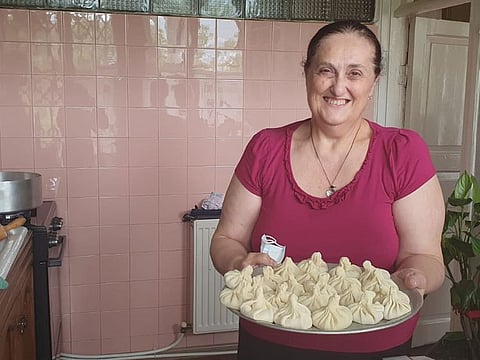Learn how to make traditional Georgian khinkali, khachapuri with Nana
Nana’s family has been in Tbilisi for generations – here’re some hand-me-downs

This is Nana’s house. It’s got rooms stacked one on top of another, like a house of cards. Nana’s house has stairs that stretch in narrow little rows all the way to the top. There is no elevator, because when Nana’s house was built there were none around.
Nana lives in Georgia’s capital, Tbilisi; here, she teaches tourists how to cook things her own mother taught her. Delicacies she learnt how to make by watching. No cups, no spoons in hand – you saw it, you tried it. You discarded what didn’t work and you memorised what did.
Now, Nana knows that when you use X amount of flour, you need Y amount of yeast to help it rise; it’s weighed in fistfuls and dustings, in amount of time spent asking a question, in passing a plate.
When she decided to spend her weekends teaching visitors how to cook family favourites – khinkali, a Georgian dumpling delicacy that’s full of flavourful broth and meat, and khachapuri, cheese-stuffed bread from scratch – it’s her daughters who weighed the powders and the liquid concoctions. It’s the kids who made note of the herbs and consistency of cheese. It’s them who made notes for the visitors and who come over every week to help her relay the knowledge.
Nana, whose family has lived in this house for generations, doesn’t speak English; she’s spoken Russian all her life, before and after the fall of the former Soviet Union. Her kids speak both Russian and Georgian. Communication with Nana is limited to smiles, nods and gentle prods; her daughters – Eka Ghoghoberidze, an oncologist with a penchant for cooking, and Keti Ghoghoberidze, a guidance counsellor – translate.
Welcome, say the three, to Nana Gabriadse’s house.
Making khinkali – which both the people of the Tusheti and Pshavi regions claim as theirs - is a family affair, say the women. “You are with your family, friends and they just sit in the kitchen and make khinkali. You really need help to make khinkali because it is not easy; for one person it is a huge job,” explains Keti. And each person, if Eka is to be believed, can happily down between 12 and 15 of them. “Sometimes people will eat the stuffing and leave the dumpling’s bob,” explains Eka. I manage a fair six.
The stuffing of khinkali is traditionally a mix of different types of meat; but you can stick to beef for a flavourful experience. And eating it can be messy; the trick lies in chomping a tiny bite out of one side and slurping the broth for a mouthful of goodness. (It’s either that or you’ll end up with a splash of oily liquid down your clothes.)
Khachapuri (“khacho” for yoghurt; “puri” for bread) is easily the most commonly found food in Tbilisi. A flaky bread gives way to warm, melting, half chewy – but not stringy – cheese – something akin to a margarita casserole.
Nana and company are quick to point out that not all cheeses are the same – this is a frequent refrain in Georgia; they are very, very fond of their dairy – and what goes into a Khachapuri is only the best, fattiest produce.
You may or may not put an egg atop your dish – this varies from season to season and from region to region – but the soul of the dish; warmth wrapped in a buttery bite, stays the same.
At one point in our masterclass, between eating another delicacy – a sweet yet tart plum sauce with freshly baked bread – Eka pulls out an old notebook. “The grandmothers would write their recipes down for the generations to follow,” she recalls. Written in the Georgian script, which has 33 letters, the lines look exotic to me and hold riddles I cannot decipher. Eka is quick to console me when I express this sentiment. “It’s got measurements we don’t understand either,” she laughs.
That’s what happens when you learn how to cook through observation. You learn measurements in fistfuls and dustings; know readiness in texture and tastings, in the bouquets of smells that follow the cook out of the kitchen; and recreate flavours you’ve grown up loving. That’s the way Nana cooks.
And the way you learn here – in Nana’s house.
Khinkali
Ingredients
Method
Khachapuri
Ingredients
Method
Sign up for the Daily Briefing
Get the latest news and updates straight to your inbox












